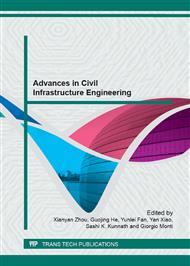[1]
JIANG G B, HE Y S. Numerical Simulation of Flow Around Two-dimensional Sinusoidal Hills Based on Non-orthogonal Collocated Grid System(in chinese)[J]. Journal of wuhan university of technology, 2010,32(3): 128-132.
Google Scholar
[2]
Jae Jin Kim, Jong Jin Baik, Hye Yeong Chun. Two-dimensional numerical modeling of flow and dispersion in the presence of hill and buildings[J]. Journal of Wind Engineering and Industrial Aerodynamics, 2001,89(10): 947-966.
DOI: 10.1016/s0167-6105(01)00092-7
Google Scholar
[3]
Juliana B R, Loureiro, Alexandre T P,Alho, Atila P. Silva Freire. The numerical computation of near-wall turbulent flow over a steep hill[J]. Journal of Wind Engineering and Industrial Aerodynamics, 2008,96(5): 540-561.
DOI: 10.1016/j.jweia.2008.01.011
Google Scholar
[4]
Bitsuamlak G T , Stathopoulos T , Bedard C. Numerical Evaluation of Wind Flow over Complex Terrain: Review[J]. Journal of Aerospace Engineering, 2004,17(4): 135-145.
DOI: 10.1061/(asce)0893-1321(2004)17:4(135)
Google Scholar
[5]
Ferreira A D, Lopes A M G, Viegas D X et al. Experimental and numerical simulation of flow around two-dimensional hills[J]. Journal of Wind Engineering and Industrial Aerodynamics, 1995,54-55: 173-181.
DOI: 10.1016/0167-6105(94)00040-k
Google Scholar
[6]
Loureiro J, Soares D, Fontoura J. et al. Water tank and numerical model studies of flow over steep smooth two-dimensional hills[J]. Boundary-Layer Meteorology, 2007,122(2): 343-365.
DOI: 10.1007/s10546-006-9100-6
Google Scholar
[7]
Launder B E, Spalding D B. Mathimatical Models in Turbulence[M]. Academic Press, 1972.
Google Scholar
[8]
Launder B E, Spalding D B. The Numerical Computation of Turbulent Flows [M]. Compu Methods in Appl Mech and Eng3, Northholland Publishing Company. 1974.
Google Scholar
[9]
TAO W Q. Numerical heat transfer (the Second Edition)(in chinese)[M]. Xi'an: Xi'an Jiaotong University Press, 2004.
Google Scholar
[10]
Ferziger J H, Peric M. Computational Method for Fluid Dynamics[M]. Springer, 2002.
Google Scholar
[11]
Usera G, Vernet A, Ferre J A. A parael block-structure Finite Volume Method for Flows in Complex Geometry with sliding Interfaces[J]. Flow Turblulence Combust, 2008, 81: 471-495.
DOI: 10.1007/s10494-008-9153-3
Google Scholar
[12]
HE Yong, HUANG She Hua, ZHANG Xiao Yuan. Numerical simulation of sinusoidal hill flow based onlow-Reynolds number k-ε two-layer model(in chinese)[J]. Engineering Journal of Wuhan University, 2004,37(04): 11-15.
Google Scholar


